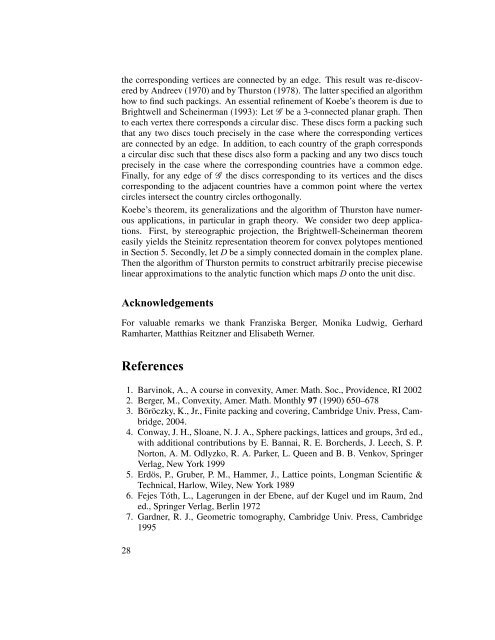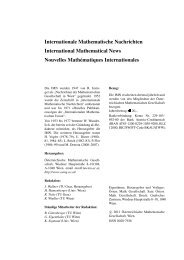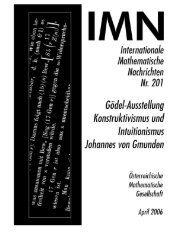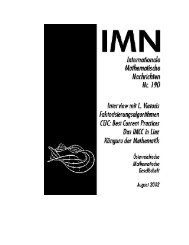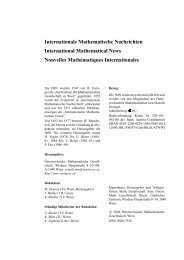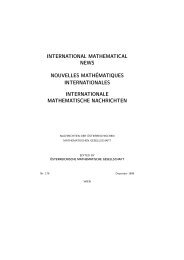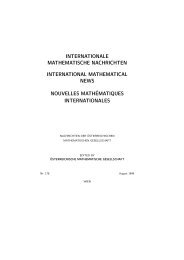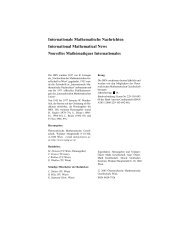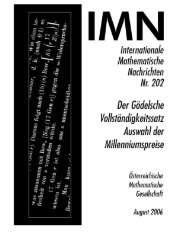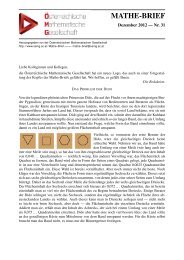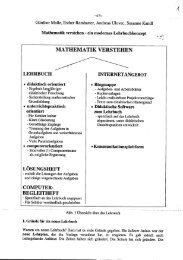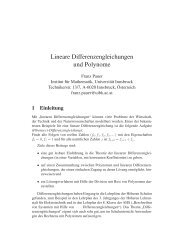199 - Ãsterreichische Mathematische Gesellschaft
199 - Ãsterreichische Mathematische Gesellschaft
199 - Ãsterreichische Mathematische Gesellschaft
Sie wollen auch ein ePaper? Erhöhen Sie die Reichweite Ihrer Titel.
YUMPU macht aus Druck-PDFs automatisch weboptimierte ePaper, die Google liebt.
the corresponding vertices are connected by an edge. This result was re-discovered<br />
by Andreev (1970) and by Thurston (1978). The latter specified an algorithm<br />
how to find such packings. An essential refinement of Koebe’s theorem is due to<br />
Brightwell and Scheinerman (<strong>199</strong>3): Let G be a 3-connected planar graph. Then<br />
to each vertex there corresponds a circular disc. These discs form a packing such<br />
that any two discs touch precisely in the case where the corresponding vertices<br />
are connected by an edge. In addition, to each country of the graph corresponds<br />
a circular disc such that these discs also form a packing and any two discs touch<br />
precisely in the case where the corresponding countries have a common edge.<br />
Finally, for any edge of G the discs corresponding to its vertices and the discs<br />
corresponding to the adjacent countries have a common point where the vertex<br />
circles intersect the country circles orthogonally.<br />
Koebe’s theorem, its generalizations and the algorithm of Thurston have numerous<br />
applications, in particular in graph theory. We consider two deep applications.<br />
First, by stereographic projection, the Brightwell-Scheinerman theorem<br />
easily yields the Steinitz representation theorem for convex polytopes mentioned<br />
in Section 5. Secondly, let D be a simply connected domain in the complex plane.<br />
Then the algorithm of Thurston permits to construct arbitrarily precise piecewise<br />
linear approximations to the analytic function which maps D onto the unit disc.<br />
Acknowledgements<br />
For valuable remarks we thank Franziska Berger, Monika Ludwig, Gerhard<br />
Ramharter, Matthias Reitzner and Elisabeth Werner.<br />
References<br />
1. Barvinok, A., A course in convexity, Amer. Math. Soc., Providence, RI 2002<br />
2. Berger, M., Convexity, Amer. Math. Monthly 97 (<strong>199</strong>0) 650–678<br />
3. Böröczky, K., Jr., Finite packing and covering, Cambridge Univ. Press, Cambridge,<br />
2004.<br />
4. Conway, J. H., Sloane, N. J. A., Sphere packings, lattices and groups, 3rd ed.,<br />
with additional contributions by E. Bannai, R. E. Borcherds, J. Leech, S. P.<br />
Norton, A. M. Odlyzko, R. A. Parker, L. Queen and B. B. Venkov, Springer<br />
Verlag, New York <strong>199</strong>9<br />
5. Erdös, P., Gruber, P. M., Hammer, J., Lattice points, Longman Scientific &<br />
Technical, Harlow, Wiley, New York 1989<br />
6. Fejes Tóth, L., Lagerungen in der Ebene, auf der Kugel und im Raum, 2nd<br />
ed., Springer Verlag, Berlin 1972<br />
7. Gardner, R. J., Geometric tomography, Cambridge Univ. Press, Cambridge<br />
<strong>199</strong>5<br />
28


